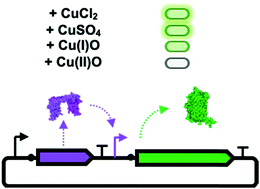Development of whole-cell and cell-free biosensors for the detection and differentiation of organic and inorganic forms of copper†
Abstract
The modern world has seen exposure of bacterial communities to toxic metals at selective levels. This manifests itself both intentionally, through medicines and un-intentionally through waste streams. There is growing concern that selective exposure to metals may be linked to microbial resistance to antibiotics. For a microbe to become resistant to a specific metal it must first come in contact with it. The transition metal copper has the ability to enter bacterial cells without need for a copper specific uptake mechanism. Copper is commonly used as an antimicrobial in the healthcare industry, consumer products and as a growth promoter of livestock in the agricultural sector. Here we report a study into the uptake of different organic and inorganic sources of copper. A whole-cell bacterial biosensor was developed to quantify the specific uptake of copper from various sources. Furthermore, a cell-free sensor was utilized to investigate the response to copper sources when uptake is eliminated as a factor. The data within suggest inorganic copper to have greatly reduced uptake compared to organic sources and that there is significant difference between copper oxides, Cu2O and CuO.



 Please wait while we load your content...
Please wait while we load your content...